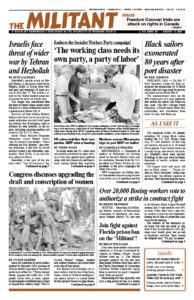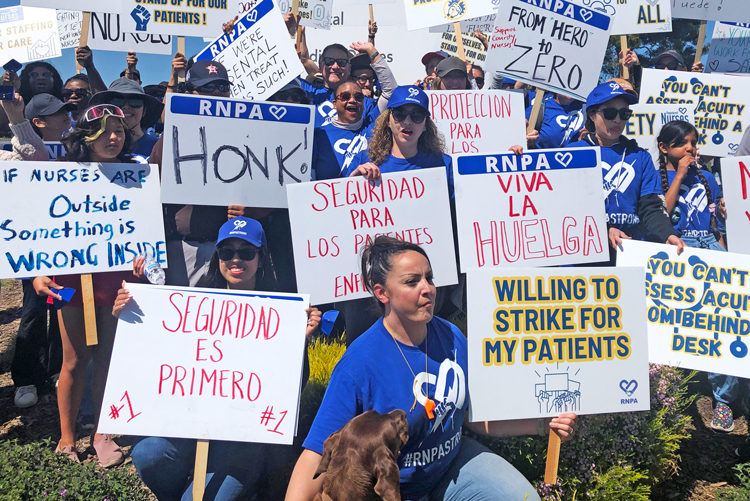In recent weeks the U.S. rulers have succeeded in reestablishing some stability in their two-capitalist-party political setup, with both Democrats and Republicans uniting behind their respective candidates, Kamala Harris and Donald Trump. They’re each setting out to rally interest and support among working people who confront the effects of a deepgoing capitalist crisis.
The 2024 election comes as a decadeslong retreat by the working class and our trade unions has come to an end. “The intensified speedup, longer and longer hours, attacks on job safety, declining real wages, lack of steady employment, and spiraling social and moral blight — conditions produced by the ruling class families in the United States and capitalism’s dog-eat-dog social relations — are pressing more and more working people to say, ‘Enough is enough,’” Socialist Workers Party leader Mary-Alice Waters writes in The Low Point of Labor Resistance Is Behind Us: The Socialist Workers Party Looks Forward.
Thousands of workers at Boeing and at ports on the East Coast are fighting for better contracts. Many more have walked picket lines in recent strikes.
The fact that workers are in the mood to fight is the key factor in politics today, creating more openings to advance a working-class road forward. It’s the reason that campaigners for the Socialist Workers Party presidential ticket — Rachele Fruit for U.S. president and Dennis Richter for vice president — find serious interest in the party’s program, especially the SWP’s call for a break with the bosses’ parties and for workers to establish a party of labor that can organize all working people into struggles to defend our own class interests.
Ever since Donald Trump emerged as a figure in capitalist politics, he has pushed to transform the way the Republican Party presents itself. “You’re going to have a workers’ party,” he said in May 2016, “a party of people who haven’t had a real wage increase in 18 years.”
He has largely accomplished this today. He invited Sean O’Brien, general president of the Teamsters, to be the first union leader in years to speak at the recent Republican convention.
For decades, Democrats claimed to be the party that stood up for workers, drawing union officials into backing so-called friends of labor on the Democratic Party line, subordinating workers’ interests to a party that defends the U.S. bosses at home and abroad.
Today tens of thousands attend Trump’s rallies as he pounds away at questions that are barely mentioned by Democrats, but resonate deeply with working people. In Grand Rapids, Michigan, July 22, Trump claimed he’d “end the inflation nightmare.” It’s “a class buster. It busts everything. Low-income, middle-income especially.”
As Trump points to the conditions bearing down on workers, he also scapegoats immigrants, seeking to divert workers’ attention from the real cause of the capitalist crisis — the bosses’ drive to profit at our expense — and to deepen divisions among workers.
Trump seeks to keep workers looking toward the bosses’ two-party setup. Nothing he says points workers toward relying on each other and our capacities for class struggle, let alone the need to organize independently of the ruling class and its parties.
Democrats pull behind Harris
Since Democratic Party bosses shoved Joseph Biden aside for Kamala Harris, a rapturous liberal media has showered her with support. “Harris raises $200mn in first week of ‘record shattering’ election campaign,” the Financial Times cooed July 29.
So far, Harris has centered her campaign largely on the same theme pushed by Biden — vilifying Trump. As a former prosecutor, “I took on perpetrators of all kinds,” she said at her first campaign event July 22. “So hear me when I say I know Donald Trump’s type.”
Biden helps push the Democrats’ line, saying July 29 that the key question in the election is the menace of Trump and his “increasing threats to America’s democratic institutions.” Behind Trump is what they really fear, the millions of workers who are looking for a change.
What Biden and Harris call “democracy” is the state apparatus that serves the U.S. imperialist rulers. All Democrats and Republicans claim this is “our” government, representing everyone.
But what working people need are protections from that state, which serves the exploiting class. That’s what was written into the Constitution — protection of the right to free speech, to bear arms, to worship freely, to a timely and fair trial and more. These rights are increasingly important as workers fight attacks from the bosses and their government today.
At a campaign event in Pittsfield, Massachusetts, July 27 Harris claimed Trump “intends to take our country backward” to “a very dark past.” She pointed to the “generations of Americans before us [who] led the fight for freedom,” referring to the struggles that toppled Jim Crow segregation.
That momentous struggle, and the ongoing fight to end the national oppression of African Americans, remains decisive to uniting the working class and charting a road toward replacing capitalist rule with a government of our own.
But advancing the fight for Black freedom has nothing to do with what Harris represents. As she proudly points out, she’s a former prosecutor, part of the rulers’ criminal “justice” system that operates to keep working people in their place. Democratic Party leaders have long claimed they speak for Black rights, but even a cursory study of U.S. history shows their record is as a bulwark of racist oppression. It was a powerful independent mass movement of working people that toppled Jim Crow and changed U.S. politics forever. From Franklin Roosevelt to Lyndon Johnson, Democrats fought it tooth and nail.
The opposite course was pursued by Malcolm X. He explained that both the two main parties upheld a system based on exploitation and oppression. He backed efforts of Black rights fighters to run independently of the Democrats and Republicans in 1964 on the Freedom Now ticket and gave encouragement to Clifton DeBerry, the Socialist Workers Party candidate for U.S. president.
For working-class political action
The rulers’ success in stabilizing their two-party system doesn’t change what faces working people.
The idea that “Republicans are more ‘reactionary’ than the Democrats … is an illusion,” James P. Cannon, a founder and central leader of the Socialist Workers Party, wrote in August 1944. “The two big class parties,” Cannon wrote, have “differences of tradition, composition, sectional interests. … But one can lose his bearing entirely if he does not recognize their secondary character.”
These differences effect how “the big capitalists have to manipulate the masses in order to assure their firm rule,” Cannon said. “But in the absence of an independent class opposition on the political field they will continue, as in the past, to solve the problem without too much difficulty.” On all the fundamental questions, he said, the two parties support the U.S. rulers.
Recognizing the pervasive anti-working-class character of the Democratic and Republican parties is the first step to understanding why breaking from them is crucial. It’s why workers should build a party of our own, a party of labor. That’s what the SWP campaign offers fighters today.


